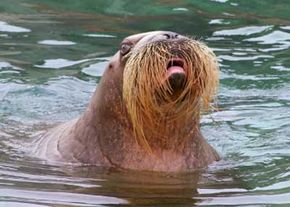Quck answer
Walruses are marine mammals that live in the Arctic regions. They have distinct features such as their long tusks, thick blubber, and sensitive whiskers. Walruses use their tusks to help them climb out of the water and to defend themselves from predators. They also have a unique ability to dive deep into the water, holding their breath for up to 30 minutes. This allows them to search for food, which mainly consists of clams and other shellfish. Walruses are social animals and can often be found in large groups, or “herds”. However, they are currently facing threats from climate change and hunting, which has led to a decline in their population.
Wild Animals
Walruses’ Sensory Organs and Feeding Habits

Walruses are adept at locating and consuming prey, but their eyesight is not particularly good. The two eyes of the walrus are located on the front of its round head, rather than on the sides. Other senses, however, do most of the work. Walruses have two small openings with protective flaps for ears, which can detect noises up to a mile (1.6 km) away. Their noses are sensitive enough to detect predators’ approach and to identify young. In addition, a walrus possesses anywhere from 400 to 700 whiskers in 13 to 15 rows around the nose, which are highly sensitive and are attached to muscles supplied with blood and nerves.
Walruses use their sensitive whiskers to locate prey. They hunt with their noses close to the sea floor, squirting water out of their nostrils to stir up burrowing prey. Walruses generally forage in groups at depths between 33 feet and 164 feet (10 m-50 m) and seem to prefer clams as a food source. They eat a variety of bottom dwellers, including worms, snails, crabs, and sea cucumbers. When walruses locate shelled prey, they use their mouths as a vacuum to suck the animal out of the shell. The suction is so powerful that walruses in captivity have sucked holes in plywood and stripped paint from walls. Walruses swallow their food whole and do not chew it. A grown walrus can consume 3,000-6,000 clams in one sitting and approximately 4.2 percent to 6.2 percent of their body weight each day.
How do walruses manage to eat underwater for so long without air, and how do they tolerate frigid water temperatures? Read on to learn how walruses have adapted to endure the harsh climate.
Too Hot to Handle
Research shows that global warming may have a negative impact on walruses. As the Earth’s average temperature increases, more and more ice in the polar region recedes, which could be devastating to walruses because they depend on the ice shelves as a resting ground between dives. The shallow waters where walruses like to feed now have little or no ice for mothers and babies to rest on when feeding, so mothers may have to travel farther to reach feeding and resting grounds and may become separated from their young. Areas that do have ice shelves are deeper, and the walruses are not accustomed to diving that deep for food. Only time will tell whether the walruses can adapt to the longer commute and deeper dives required because of the ice’s retreat.
FAQ
1. What are walruses?
Walruses are large marine mammals that live in the Arctic waters of Canada, Greenland, Russia, and Alaska. They are known for their large tusks, which are actually elongated canine teeth, and their thick blubber, which helps them survive in cold waters.
2. What do walruses eat?
Walruses primarily eat clams and other shellfish that they find on the ocean floor. They use their sensitive whiskers to locate their prey and their strong tusks to break open the shells. They may also eat fish and other marine invertebrates.
3. How do walruses communicate?
Walruses communicate with each other using a variety of sounds, including grunts, whistles, and bellows. These sounds are used to establish dominance, attract mates, and warn of danger.
4. How do walruses swim?
Walruses are powerful swimmers and can dive to depths of up to 300 feet. They use their front flippers to propel themselves through the water and their back flippers to steer. They can also hold their breath for up to 30 minutes.
5. How do walruses protect themselves?
Walruses have a few different ways of protecting themselves. Their thick blubber provides insulation against the cold and also helps them stay afloat in the water. Their tusks can be used to defend against predators or to establish dominance within their social groups. They may also use their large bodies to crush predators against the ocean floor.
6. How do walruses mate?
Walruses typically mate in the water during the summer months. Males will compete for the attention of females, and the dominant male will mate with multiple females. After a gestation period of about 15 months, the female will give birth to a single calf.
7. How many walruses are left in the world?
It is estimated that there are around 200,000 walruses left in the world. This number has decreased in recent years due to climate change and hunting by humans.
8. Are walruses endangered?
While walruses are not currently listed as endangered, they are considered a vulnerable species due to the threats they face from habitat loss and hunting. Conservation efforts are underway to protect these animals and their habitats.
9. Can walruses be kept as pets?
No, walruses are wild animals and cannot be kept as pets. It is also illegal to capture or kill walruses without proper permits and regulations.
10. How can I help protect walruses?
You can help protect walruses by supporting organizations that work to conserve their habitats and advocate for their protection. You can also reduce your own carbon footprint to help combat the effects of climate change, which is a major threat to these animals.





Leave a Reply